The Proof is in the Pudding: Scarsdale Students Shine On Assessments and Beyond
- Category: Schools
- Published: Wednesday, 23 October 2024 09:45
- Wendy MacMillan
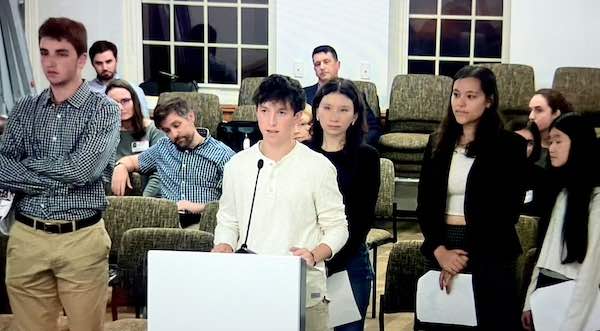 Despite the COVID crisis and the many curveballs life has thrown at them Scarsdale students continue to shine. And, as made evident through an Education Report given at the Board of Education meeting on Monday, October 21st, our students are excelling, far beyond the traditional metrics for measuring student achievement. In his annual Assessment Report this year, Assistant Superintendent of Curriculum, Dr. Edgar McIntosh detailed how Scarsdale students fared on standardized tests, and expanded his report to include a more holistic look at student achievement.
Despite the COVID crisis and the many curveballs life has thrown at them Scarsdale students continue to shine. And, as made evident through an Education Report given at the Board of Education meeting on Monday, October 21st, our students are excelling, far beyond the traditional metrics for measuring student achievement. In his annual Assessment Report this year, Assistant Superintendent of Curriculum, Dr. Edgar McIntosh detailed how Scarsdale students fared on standardized tests, and expanded his report to include a more holistic look at student achievement.
To begin, McIntosh and Superintendent Dr. Drew Patrick, gave a brief overview of the District’s newly developed, long term strategic plan that includes goals in the areas of Learning, Living, and Leading.

Patrick explained that each of the three goals contains an agreed upon set of priorities that are thoughtfully and collaboratively, researched, implemented, supported, and assessed on an on-going basis. For a better understanding of each of the Strategic Plan’s goals and priorities, you can see the slides of the presentation here.
After this brief overview, Mcintosh went on to say, “Tonight, we'll focus on standardized measures of student success. While these numbers highlight our achievements, they don't tell the full story. Our presentation, titled "A Holistic Approach to Assessments," aims to explore the development of essential skills and dispositions in our students.”
In what was perhaps the highlight of the Education Report, McIntosh introduced five SHS students who joined the meeting to share the learning, growth, and real-world skills they have attained in the newly added Financial Literacy class at the high school. In their presentation, the students, who each spoke with the poise and confidence of a seasoned professional, described the areas of study in their class including, Banking and Budgeting, Debt, Investing, Risk, and Taxes. In their descriptions of the class activities, the students detailed how they researched student loans and debated whether or not college should be free, took part in budgeting exercises for three different economic statuses, and learned to create and use amortization tables and how monthly loan payments are distributed between interest and principal over time. (Pictured at top are SHS students: Amelia Grossi-Romano, Mer Goh , Matan Davies, Zach Weinberg and Stacey Liew.)
Beyond developing financial literacy, the student’s presentation demonstrated examples of collaboration, creative problem solving, leadership, applying knowledge across disciplines, and many more skills that directly contribute to SHS’s Profile of a Graduate.
After the student’s presentation, McIntosh moved into the more traditional review of the results of many of Scarsdale’s Schools 2024 benchmark measures and standardized assessments, from 3rd-grade state testing- through APs, and SATs. As he stated, “What will be evident is that Scarsdale continues to maintain and demonstrate high levels of achievement through several standardized means- consistent with previous years.”
The first two slides of the presentation related that 99% of SHS students move on to a four year college after graduation and 73% are accepted to a top 50 university or top 50 liberal arts college as defined by US News. While these statistics are impressive and many in our community are eager to know these data points, Dr. Patrick cautioned against giving information like this to much weight, saying:
“We feel it is important to emphasize that there are numerous methodologies (literally dozens) for determining “quality”. Many people talk about selectivity, which typically boils down to the single stat of admissions rate (most selective ~<10%; highly selective~10%-25%; very selective ~25-50%; less selective ~50-75%; least selective ~>75%). US News does not use this data point at all. Further, it has always made us uncomfortable to report this data, as it is in opposition to how the high school (and most high schools) work with students and families to find the school that is best for them, and emphasizing any particular collection of schools rubs against the grain of the work. However, we understand that the community sees this as an essential outcome and therefore it is reasonable to expect this to be reported. We will also note that this excludes students who apply to and matriculate at schools outside of the U.S.”
McIntosh added, “Drew expressed a concern that I echo- even in a dynamic list, there are schools that are missing that don’t reflect the range of schools that are of high interest to many of our students and families, ones with special areas of expertise, highly regarded school and ones historically desirable to our community that are disadvantaged by the weighing of the criteria- and international schools are not considered. And notably, we have 14 students attending international schools. There is a link in supporting documentation to the USN&WR website which includes the metrics they use to rank the schools.”
These sentiments were supported by many other BOE members. Though many agree that focusing on colleges that are a good “fit” for the specific student is preferable, it’s hard to deny that with their stellar test scores, SHS students seem well prepared for whichever college they end up going to.

“As has been our practice, here is comparison data with local high-performing Districts in the SAT and the ACT In 2024. Scarsdale continues to be a leader in the region.”
In his review of test results at the high school level, McIntosh noted, “There has been a marked increase in students taking the exam- 24% increase in total students, and a 69% increase in total exams with younger students sitting for them. I’ve spoken to the counseling department about this trend. Oren and his team say there is a mistaken belief from community members that taking AP exams will provide an advantage in college placement decisions. This is not backed up with what admissions officers are telling us.”

BOE member Amber Yusef felt that the Board should keep their eye on this explosive growth in the number of AP test takers and the number of AP tests they are taking. She questioned if there is something else going on and wonders if this will become a trend. She also noted that students considering applying to international schools do need to take AP exams.
Another BOE member, Jim Dugan, pointed out that more students have been applying to state schools, which are more likely to accept AP classes for college credit. The ability to opt out of a college class and save money, might incentivize more people to take the AP tests.
In another slide, a chart shows the percentage of our students who have successfully passed the required regents exams in algebra, ELA, Biology, Global History and US. History and Government.

Before discussing the K-8 standardized testing measures, McIntosh took a moment to remind everyone that, “State assessments are just a small tip of the iceberg of the ways we assess our students. For a fuller picture, take a look at the first section of supporting documentation. These pages describe the multitude of ways we assess, monitor, and evaluate our student performance through common benchmark assessments, formative assessments, and progress monitoring tools. These assessments provide more nuanced and actionable data than the snapshot these assessments provide.”
He also took a moment to clarify, “At the elementary and middle school level, we appreciate standardized assessments have their place- and provide broad measures of topic coverage and concept understanding-. They are , we know, inconsistent in reliably and accurately measuring individual students' abilities. When a student does poorly on an exam, however, it sets in motion team review.”
“The next two new slides show our students' performance on the new science assessment given this year. These exams are aligned with the Next Gen Standards in Science. Our students performed near the top of our compassion districts in this area. That said, the 5th grade exam is going through some careful review at the state level based on critical feedback on various factors, including the amount of time students needed to complete it.”
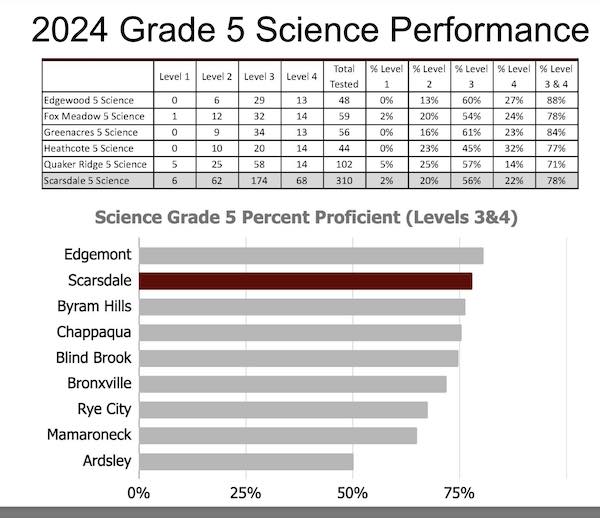

Of the next slide McIntosh said, “On this slide, you will see that our students continue to perform within the historically high percentages on the ELA state exam. This slide highlights six years of the exam in which the format of the exam was the same. As described, there are no scores to report for 2020, and flawed 2021 scores do not provide helpful comparisons. Please know that we have included the longer history of performance in the supporting documentation.”

As in past years, the report provided comparisons to an average of a high-performing cohort of Districts, the lower Hudson region, and statewide percentages.
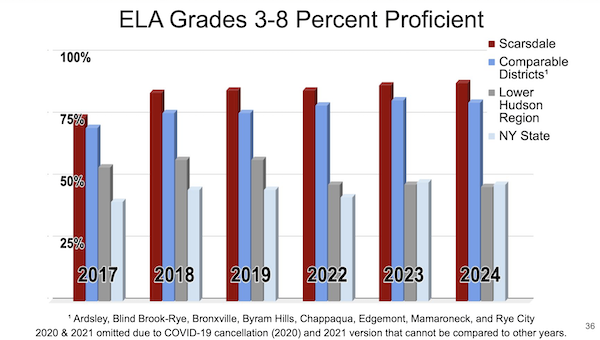
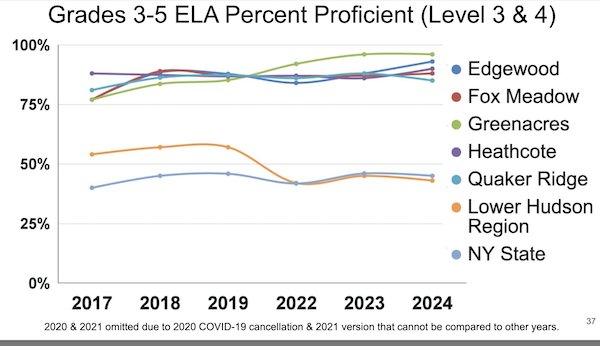
Next, the presentation covered math performances and made clear that students continue to perform within the historically high percentages.
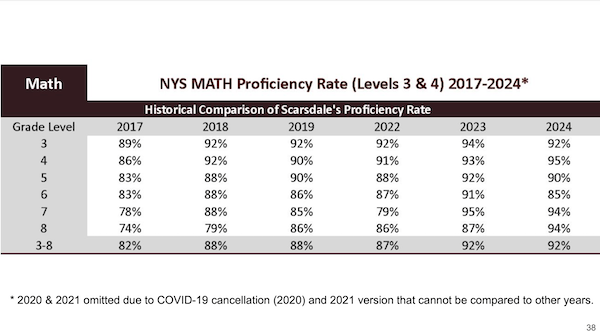

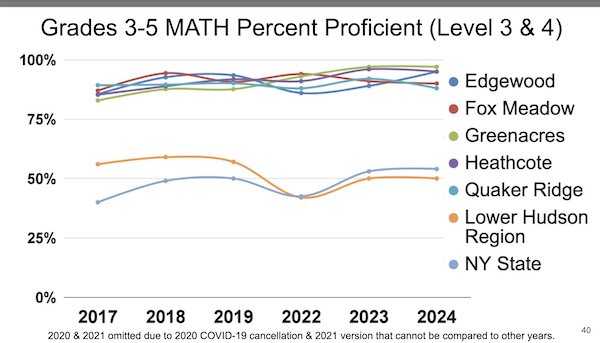
McIntosh took a moment to make note of the District’s math curriculum saying:
“As described in past education reports, Reveal Math resources are evidence based and built on established and effective pedagogy--- But it is essential that we build on outside research and respond to the lived experience of our students and teachers, and survey educators and assess students to drive improvements in this area.
Based on internal research, Program Improvement Days over the summer focused on:
-Building in addition Enrichment and Extension experiences
-Aligning and adapting Benchmarking and Performance Assessments
-Critical assessment and adjustment of program sequencing and Unit Order
-And leaning into the powerful practice of building and Using Games to Extend skills and conceptual understanding”
This comprehensive Education Report certainly made clear that Scarsdale students continue to be high performing test takers. But more than that, this holistic review of assessments illustrates that our District sure seems to be meeting its Strategic Plan “Learning Goal” of:
“Promote a collaborative academic culture where confident and creative risk takers bring voice to their passions, think deeply about what they are learning, solve problems in increasingly sophisticated ways, and communicate what they know and can do through a wide range of performance tasks and assessments that occur within and beyond the classroom.”
See the Education Report here:







